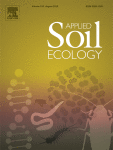Ver ítem
- xmlui.general.dspace_homeCentros e Institutos de InvestigaciónCICVyA. Centro de Investigación en Ciencias Veterinarias y AgronómicasInstituto de BiotecnologíaArtículos científicosxmlui.ArtifactBrowser.ItemViewer.trail
- Inicio
- Centros e Institutos de Investigación
- CICVyA. Centro de Investigación en Ciencias Veterinarias y Agronómicas
- Instituto de Biotecnología
- Artículos científicos
- Ver ítem
Unveiling changes in the rhizosphere bacteriome of sunflower (Helianthus annuus L.) inbred lines linked to their resistance to the soil borne pathogen Verticillium dahliae Kleb
Resumen
Plants infected by fungal pathogens often actively recruit microbes in their roots to protect themselves. It is widely accepted that the plant microbiome plays a crucial role to sustain the fitness, resilience and development of the plant holobiont, and that the host actively shapes the rhizosphere microbiome to prevent or suppress soil borne diseases. Here, we studied the rhizosphere bacterial communities of three sunflower inbred lines (ILs) with
[ver mas...]
Plants infected by fungal pathogens often actively recruit microbes in their roots to protect themselves. It is widely accepted that the plant microbiome plays a crucial role to sustain the fitness, resilience and development of the plant holobiont, and that the host actively shapes the rhizosphere microbiome to prevent or suppress soil borne diseases. Here, we studied the rhizosphere bacterial communities of three sunflower inbred lines (ILs) with different level of resistance to Verticillium dahliae Kleb. We used 16S rRNA gene amplicon sequencing to profile bacterial communities before and after inoculation with V. dahliae. Overall, there was no significant association of alpha diversity indices with sunflower ILs and inoculation of the pathogen. However, a moderate increase in the richness and diversity was observed with the increment of resistance. In contrast, there were clear differences in the rhizosphere bacterial community structures related to the level of susceptibility of the sunflower genotypes. The predominant phyla comprised Proteobacteria, Bacteroidetes, and Acidobacteria. At the genus level, Rhodanobacter, Chujaibacter, Flavitalea, Lysobacter, Devosia, Bryobacter, Dokdonella and Bradyrhizobium were the most abundant genera in all cases. Our results indicate that sunflower genotype and V. dahliae infection of roots led to considerable changes in the composition of the rhizosphere bacterial communities. Changes were mostly observed in the relative abundances of core microbiome members, which varied significantly and differentially depending on the sunflower ILs and its level of resistance to V. dahliae. Thus, harnessing sunflower-associated rhizosphere bacteriomes for disease control may offer a valuable alternative strategy to increase the productivity and sustainability of agricultural production for this crop.
[Cerrar]

Autor
Ben Guerrero, Emiliano;
Lasa, Ana V.;
Aguilera, Pablo Nicolás;
Fernández-González, Antonio J.;
Martinez, Maria Carolina;
Mercado Blanco, Jesús;
Fernández-López, Manuel;
Paniego, Norma Beatriz;
Fuente
Applied Soil Ecology 206 : 105915 (February 2025)
Fecha
2025-02
Editorial
Elsevier
ISSN
0929-1393
Documentos Relacionados
Formato
pdf
Tipo de documento
artículo
Proyectos
(ver más)
INTA/2023-PD-L01-I089, Microbiomas en ecosistemas agropecuarios: la conexión integradora del enfoque Una Salud
INTA/2023-PD-L01-I087, Caracterización de la diversidad genética de plantas, animales y microorganismos mediante herramientas de genómica aplicada.
Palabras Claves
Derechos de acceso
Restringido
 Excepto donde se diga explicitamente, este item se publica bajo la siguiente descripción: Creative Commons Attribution-NonCommercial-ShareAlike 2.5 Unported (CC BY-NC-SA 2.5)
Excepto donde se diga explicitamente, este item se publica bajo la siguiente descripción: Creative Commons Attribution-NonCommercial-ShareAlike 2.5 Unported (CC BY-NC-SA 2.5)


